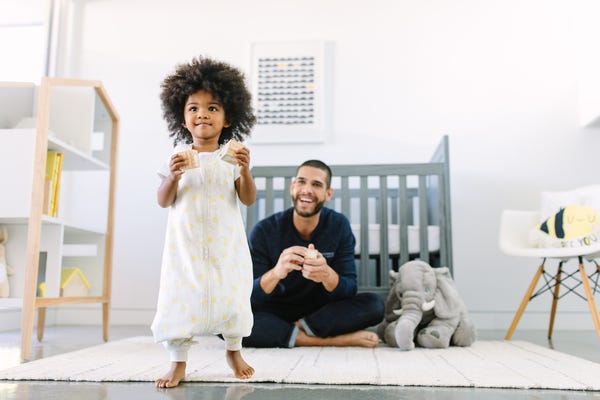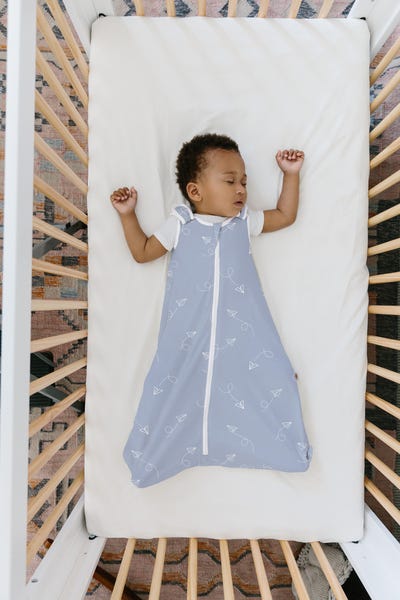
February 27, 2023
Across cultures and backgrounds and every type of parent, the dreams for our kids vary. And while no study can confirm this, we think we can safely guess that every parent would agree on two basic hopes they have when they enter parenthood: that their baby will sleep and their baby will be safe.
Many people claim to have the secret ingredient to helping your little ones sleep better (and therefore, helping you sleep better). While we can’t claim to have the magic formula, we CAN give you some sleep tips for what helps: swaddlers and sleep sacks.
But we can’t talk about sleep without talking about sleep safety! The American Academy of Pediatrics, CDC, and many healthcare providers around the world offer guidelines for a safe sleep environment for babies. One of those safe sleep practices is to not use a loose blanket or bedding, but they agree that swaddling and the use of wearable blankets or sleep sacks for babies are safe when done right.

 Sleep sacks are also called a wearable blanket for toddlers because it doesn’t restrict movement like a swaddle. They are more loose-fitting so babies and toddlers can move their arms and legs.
Baby sleep sacks and On-the-move walking sleep sacks are:
Sleep sacks are also called a wearable blanket for toddlers because it doesn’t restrict movement like a swaddle. They are more loose-fitting so babies and toddlers can move their arms and legs.
Baby sleep sacks and On-the-move walking sleep sacks are:
 Swaddling, although deemed safe by professionals, is still a highly debated topic. Some people might feel like it’s uncomfortable for the baby or unkind to restrict the baby’s movement, but studies have actually shown that swaddling helps them feel more safe and secure. In the newborn phase, the majority of their movement is, like we mentioned above, more jerky and startling, so as they are learning how to move their body, this provides a relaxing moment while they rest.
Why you should swaddle newborns
Swaddling, although deemed safe by professionals, is still a highly debated topic. Some people might feel like it’s uncomfortable for the baby or unkind to restrict the baby’s movement, but studies have actually shown that swaddling helps them feel more safe and secure. In the newborn phase, the majority of their movement is, like we mentioned above, more jerky and startling, so as they are learning how to move their body, this provides a relaxing moment while they rest.
Why you should swaddle newborns
 Sleep sacks are a great way to transition babies who are now rolling over out of swaddles. They still provide a sense of comfort and warmth, but now allow a little more movement for your growing little one.
Why you should use a sleep sack
Sleep sacks are a great way to transition babies who are now rolling over out of swaddles. They still provide a sense of comfort and warmth, but now allow a little more movement for your growing little one.
Why you should use a sleep sack

10 Game-Changing Baby Sleep Products to Help Children Sleep Better
What’s the difference between a swaddler and a sleep sack?
Swaddlers are blankets designed to be wrapped around a baby keeping their arms down at their sides or on their chest or stomach. This mimics the cozy feeling they had while in utero, but it also helps prevent their startle reflex (newborns tend to jerk their arms and legs a lot, this is known as the startle reflex), which is a common culprit for frequent waking. Swaddling a newborn makes them feel safe and secure and also helps keep them snug and warm while they sleep. Baby swaddlers are:- Snug, tight-fitting, restrictive (which makes them safe for use)
- Safe for babies from birth till they are rolling over on their own
- Good to use at naptime or bedtime
Baby Sleep Sacks
 Sleep sacks are also called a wearable blanket for toddlers because it doesn’t restrict movement like a swaddle. They are more loose-fitting so babies and toddlers can move their arms and legs.
Baby sleep sacks and On-the-move walking sleep sacks are:
Sleep sacks are also called a wearable blanket for toddlers because it doesn’t restrict movement like a swaddle. They are more loose-fitting so babies and toddlers can move their arms and legs.
Baby sleep sacks and On-the-move walking sleep sacks are:
- Made with snaps, velcro or zippers so they’re easy to get on and off to easily transition from naptime to playtime to bedtime, as well as for middle-of-the-night diaper changes. (Because they zip or close this makes them safe for use as they won’t cover your little one’s airways.)
- Safe for use for babies and into toddlerhood.
- Good to use at naptime or bedtime
Swaddling a Newborn
 Swaddling, although deemed safe by professionals, is still a highly debated topic. Some people might feel like it’s uncomfortable for the baby or unkind to restrict the baby’s movement, but studies have actually shown that swaddling helps them feel more safe and secure. In the newborn phase, the majority of their movement is, like we mentioned above, more jerky and startling, so as they are learning how to move their body, this provides a relaxing moment while they rest.
Why you should swaddle newborns
Swaddling, although deemed safe by professionals, is still a highly debated topic. Some people might feel like it’s uncomfortable for the baby or unkind to restrict the baby’s movement, but studies have actually shown that swaddling helps them feel more safe and secure. In the newborn phase, the majority of their movement is, like we mentioned above, more jerky and startling, so as they are learning how to move their body, this provides a relaxing moment while they rest.
Why you should swaddle newborns
- Safer sleeping
- Soothing and secure for newborns
- Babies tend to cry less when swaddled
- Controls the startle reflex
- Can help babies with infant reflux
How to safely swaddle a newbornEmbrace Creative Ways to Soothe Your Baby
- Wrap snugly but not too tightly. Babies should be able to breathe normally and move their hips (bend up and out at hips), but the swaddle blanket shouldn’t be so loose that it could come undone while a baby is sleeping.
- The top of the swaddle blanket should be below a baby’s mouth, around their chest and shoulders.
- Lay a baby on their back to sleep after being swaddled.
- Swaddle during the right times, i.e. naptime and bedtime, nighttime feedings and if the baby is being really fussy and won’t calm down another way.
- Don’t let your baby overheat. Put your baby in lightweight clothing under the baby swaddle and keep the room temperature that they’re sleeping in between 68-72 degrees Fahrenheit.
How To Get Your Baby to Fall Asleep
When to Transition Out of Baby Swaddle Blankets
Stop swaddling when your baby shows signs of rolling over and/or they’re becoming more physically active. This is when you should transition to a wearable sleep sack. Some say to stop around 2 months old, while others say 4 months. Each baby develops differently. Shop Ergobaby swaddlersUsing a Sleep Sack
 Sleep sacks are a great way to transition babies who are now rolling over out of swaddles. They still provide a sense of comfort and warmth, but now allow a little more movement for your growing little one.
Why you should use a sleep sack
Sleep sacks are a great way to transition babies who are now rolling over out of swaddles. They still provide a sense of comfort and warmth, but now allow a little more movement for your growing little one.
Why you should use a sleep sack
- Safe alternative to a loose blanket that will keep your baby warm and cozy during naps and bedtime.
- Sleep cue/association
- Reduced risk of SIDS
- Can be used for babies and toddlers (depending on the size/style of the sleep sack and size of your child)
- Can keep baby warm and cozy with easy access to change a diaper during the night
- Provides a smooth transition after using a swaddle
-
- Right time and place, i.e. naps and bedtime
- Lay baby on a firm, flat surface on their backs to sleep. If your baby rolls over, it’s OK in a wearable sleep sack because their arms are out and legs have mobility, so they’re safe as long as they can roll onto their stomach and back on their own.
- Dress appropriately to keep your baby warm but not overheat, and maintain a room temperature that won’t cause your baby to overheat or get too cold.
- Make sure any snaps, velcro or zipper are safe and secure so they won’t get stuck or hurt your baby.
- Start using around 2-4 months old (once a baby is more active/rolling) and stop using around 2 years old. As your little one grows you can transition to the on-the-move toddler sleep sack.
























